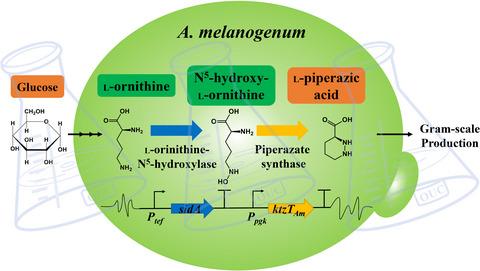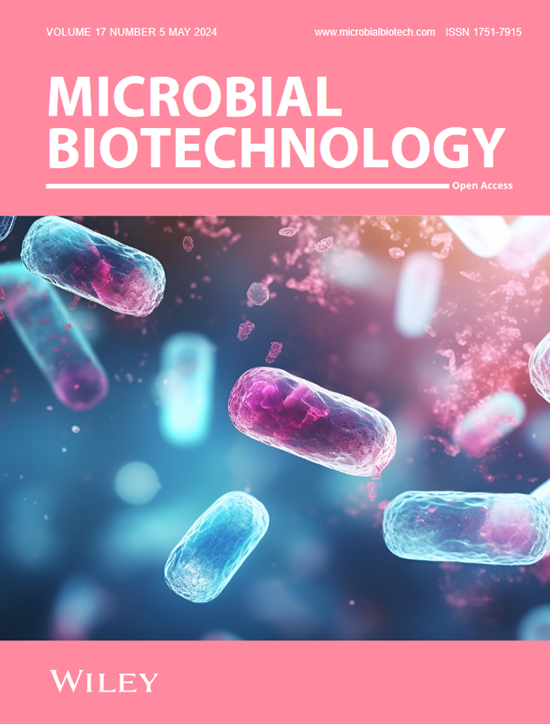Bioproduction of L-piperazic acid in gram scale using Aureobasidium melanogenum
IF 5.2
2区 生物学
Q1 BIOTECHNOLOGY & APPLIED MICROBIOLOGY
引用次数: 4
Abstract
Currently, piperazic acid is chemically synthesized using ecologically unfriendly processes. Microbial synthesis from glucose is an attractive alternative to chemical synthesis. In this study, we report the production of L‐piperazic acid via microbial fermentation with the first engineered fungal strain of Aureobasidium melanogenum; this strain was constructed by chassis development, genetic element reconstitution and optimization, synthetic rewiring and constitutive genetic circuit reconstitution, to build a robust L‐piperazic acid synthetic cascade. These genetic modifications enable A. melanogenum to directly convert glucose to L‐piperazic acid without relying on the use of either chemically synthesized precursors or harsh conditions. This bio‐based process overcomes the shortcomings of the conventional synthesis routes. The ultimately engineered strain is a very high‐efficient cell factory that can excrete 1.12 ± 0.05 g l‐1 of L‐piperazic acid after a 120‐h 10.0‐l fed‐batch fermentation; this is the highest titre of L‐piperazic acid reported using a microbial cell factory.

利用黑毛霉生产克级l -哌酸的研究
目前,哌酸的化学合成是采用对生态不友好的工艺。微生物从葡萄糖合成是化学合成的一个有吸引力的替代品。在这项研究中,我们报道了用第一株工程真菌黑毛小孢子菌进行微生物发酵生产l -哌嗪酸;通过构建菌基、遗传元件重构与优化、合成重布线和本构遗传电路重构等步骤构建该菌株,构建稳健的l -哌酸合成级联。这些基因修饰使黑孢霉能够直接将葡萄糖转化为l -哌酸,而不依赖于使用化学合成的前体或恶劣的条件。这种生物基工艺克服了传统合成路线的缺点。最终的工程菌株是一个非常高效的细胞工厂,经过10.0-l补料分批发酵120 h,可排出1.12±0.05 g -l -哌酸;这是使用微生物细胞工厂报道的l -哌酸的最高滴度。
本文章由计算机程序翻译,如有差异,请以英文原文为准。
求助全文
约1分钟内获得全文
求助全文
来源期刊

Microbial Biotechnology
BIOTECHNOLOGY & APPLIED MICROBIOLOGY-MICROBIOLOGY
CiteScore
9.80
自引率
3.50%
发文量
162
审稿时长
6-12 weeks
期刊介绍:
Microbial Biotechnology publishes papers of original research reporting significant advances in any aspect of microbial applications, including, but not limited to biotechnologies related to: Green chemistry; Primary metabolites; Food, beverages and supplements; Secondary metabolites and natural products; Pharmaceuticals; Diagnostics; Agriculture; Bioenergy; Biomining, including oil recovery and processing; Bioremediation; Biopolymers, biomaterials; Bionanotechnology; Biosurfactants and bioemulsifiers; Compatible solutes and bioprotectants; Biosensors, monitoring systems, quantitative microbial risk assessment; Technology development; Protein engineering; Functional genomics; Metabolic engineering; Metabolic design; Systems analysis, modelling; Process engineering; Biologically-based analytical methods; Microbially-based strategies in public health; Microbially-based strategies to influence global processes
 求助内容:
求助内容: 应助结果提醒方式:
应助结果提醒方式:


